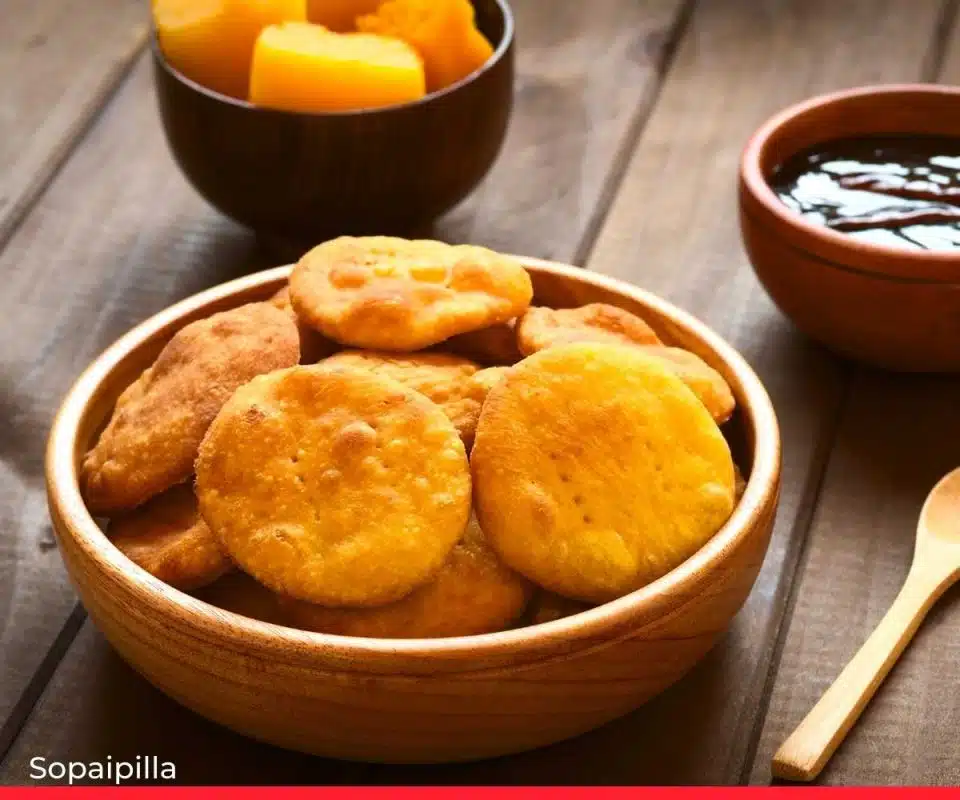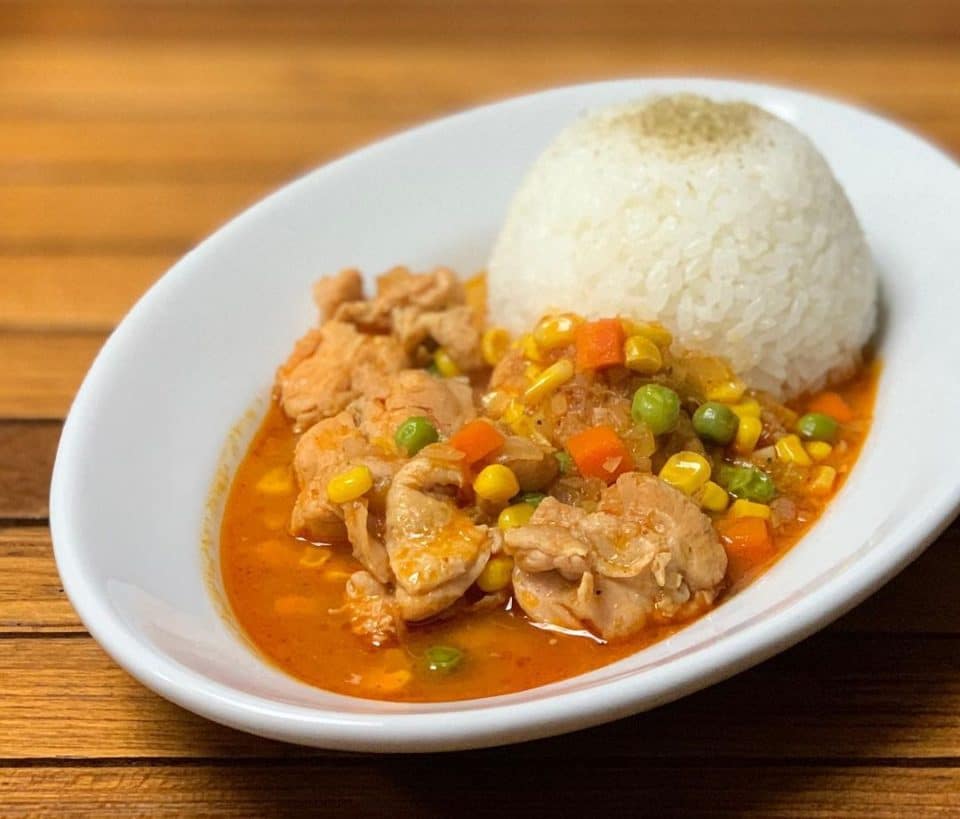Chile is not wildly famous for its gastronomy. And that’s probably because most of the country’s typical dishes are not fancy or complex, let alone pretentious.
However, the raw ingredients available are unbelievably good and fresh. The country’s cuisine includes a great variety of fruit and vegetables, and is abundant in fish and seafood.
And because the country is so long and thin with huge differences in geography and climate, there are regional specialties that vary widely between the north and the south.
Let’s round up some of the best and most popular Chilean foods and dishes.
1. Pastel de Choclo

Chile’s most iconic dish is based on a variant of corn called choclo, which is slightly sweet. While there are many different versions of this dish, the most typical consists of a purée of corn mixed with basil and coriander, ground beef, onions, a piece of chicken, hard-boiled eggs cut in quarters, and a few black olives.
Pastel de choclo is typically prepared in clay pots and cooked slowly in the oven. Most people add sugar on top to give it a crust and serve it with fresh tomato salad as a side – and a glass of Chilean red wine such as a Carménère.This is quite a heavy dish that really warms you up. Unfortunately, choclo can only be found in summer. So you basically get a heavy, winter-like dish while it’s hot and dry outside. But that doesn’t matter: it’s delicious!
2. Empanada de Pino

Chile’s favorite snack / appetizer / street food. While you can find empanadas (a pastry stuffed with a variety of ingredients) in several South American countries, the recipes are different in each of them. In the case of Chile, the specialty is empanada de pino (which, by the way, has nothing to do with a pine tree!).
The pino is an empanada filling of ground beef and cooked onions, a couple of olives, and a quarter of hard-boiled egg. Once cooked in the oven, it comes out looking like a mini version of the Italian calzone. Another local favorite is empanada camaron-queso, which is stuffed with shrimp and cheese. But rather than being baked in the oven, these are fried.
3. Pan Batido con Palta

This is a very basic, simple dish: a slice of bread, covered with mashed avocado (palta) and a hint of salt. Nothing else. However, it comes high up on this list as this is a staple of the Chilean diet.
Most families eat this every day, either at breakfast or at ‘once’, which in Chile is a lighter version of dinner. You will even find burgers filled with mashed avocado in McDonald’s!
4. Cazuela

This is not a dish to be found in fancy restaurants. It’s a homemade, countryside stew that contains a lot of ingredients: pieces of beef (or chicken), onions, carrots, pumpkin or squash, potatoes, rice, and corn husks. It is all cooked together slowly in water and flavored with garlic, salt, pepper, coriander, and merkén, a local spice made of smoked chili peppers, similar to paprika.
Cazuela is usually served in clay pots, and when well made, the meat will fall off the bone and the vegetables will be so soft that they almost melt in the mouth. It’s a great, filling dish for winter.
5. Mote con Huesillo

Officially, this is a drink. In our opinion, it contains way too many solid elements for it to be considered a beverage, however, but we will let you decide!
Mote con huesillo is basically a dried peach placed in its own juice that’s mixed with caramelized sugar, water, and a hint of cinnamon. This creates a kind of syrup, to which you add a fair amount of cooked mote, a local type of barley.
This “drink” is typically served on stands in the street, especially in summer. It is supposed to be refreshing… But honestly, you could have it for dessert instead, with a glass of water handy as it will likely make you thirsty!
6. Pastel de Jaiva

Another heavy dish, this crab casserole is made with jaiva, a local crab, and a thick sauce of tiny pieces of crustless bread, garlic, onions, cream, white wine, butter, and a few spices.
Chileans don’t shy away from putting large quantities of crab in their dishes; however, some more humble versions of it include fish stock as well. Just like pastel de choclo, it is usually baked in clay pots.
Parmesan cheese (or similar) is added on top as a gratin. A glass of chilled white wine goes very well with this dish. Learn more about food & wine pairings here.
7. Locos Mayo

Loco means crazy, but it is also the name of Chile’s most popular shellfish. And for good reason: the natives are locos about their locos, which are actually a local variety of abalone. Chileans love to have them as an appetizer with homemade mayonnaise.
Locos are slowly cooked in water until they are bland, then served lukewarm over a bed of lettuce and mayonnaise.
Unfortunately, these days abalones are overfished despite restrictions and might soon become an endangered species.
8. Cordero al Palo

This is a specialty from Patagonia, which covers the south of both Chile and Argentina. Cordero al palo means lamb on a stick, and that’s exactly what it is. The entire animal is stretched over two crossed spits and slowly cooked for several hours over a wood fire.
The juice and fat of the cordero keep the meat moist, and the result is one of the most delicious lamb dishes in the world, tender and tasty, with crispy skin, probably rivaled only by Greek lamb.
This dish is typically served with pebre, a kind of salsa that we describe later, and a glass of heavy red wine like Cabernet-sauvignon or Carménère.
9. Sopaipilla

This is one of Chile’s favorite snacks/appetizers. It looks like a round, tiny piece of bread. But it’s a special kind of spongy bread using fresh pumpkin for the dough.
The sopaipillas are gently fried and can be eaten alone or with butter, spicy sauce, tomato… or even better, with pebre, the salsa we previously mentioned. There is also a sweet version called sopaipillas pesadas, which is very popular on cold, rainy winter days.
This involves a serving of chancaca on top. And what is chancaca, you may wonder? It’s a warm syrup made with raw, unrefined sugar with a bit of orange peel and cinnamon.
10. Pebre & Chancho en Piedra

We’ve mentioned it twice already, so perhaps it’s time to tell you about pebre. This is the Chilean salsa, widely popular throughout the country and served pretty much everywhere.
There are many different recipes but the basics remain the same: olive oil, lemon juice, onions, garlic, coriander, and spicy chili peppers, all chopped into tiny pieces and blended together. When served fresh, the texture is soft and crunchy.
Add tomatoes to it and it becomes chancho en piedra, literally “pig in stone”, because it is usually prepared in a stone mortar. Chancho en piedra is softer and more liquid than pebre. Typically, you would have this sauce on bread and butter as an appetizer, but it also goes very well with heavy meat dishes like pastel de choclo, sopaipillas, etc.
11. Completo, Italiano & Churrasco

OK, that’s three in one, but that’s because we’re talking about sandwiches here. Completo is the Chilean version of the hot dog and is the most popular sandwich in Chile.
What makes it different – and arguably better – is the fact that a good amount of mashed avocado is used. And when the toppings include avocado, tomato (or ketchup), and mayonnaise, it is called Italiano, as it represents the colors of the Italian flag.
Churrasco is similar to completo, but instead of a sausage, it is made with thin slices of grilled steak.
12. Barros Luco & Chacarero

When was the last time you had a president for lunch? Well, the people of Chile do every time they have a Barros Luco.
It looks a bit like an American cheeseburger, with thin slices of grilled beef steak topped with cheese and served inside a bun or fresh bread roll. It got its name from former Chilean president Ramón Barros Luco, who was a great fan of this particular sandwich.
Now, if you want to raise the ante, say hello to the chacarero. It is similar to the Barros Luco, but comes with additional layers of green beans, slices of tomato, and hot chili peppers. And you can also add mashed avocado.
13. Alfajores

Chile’s favorite pastry – although it happens to be Argentina’s favorite dessert as well and is found in many other Spanish-speaking countries. The preparation varies from one country to another.
The Chilean alfajor is usually composed of two light, crispy biscuits made with egg yolks and cornstarch. The two biscuits are stuck together with a layer of manjar, aka dulce de leche, a kind of soft caramel. After, the alfajor can be coated in dark chocolate, or covered with coconut powder.
They are very popular as a sweet snack or along with tea. As for the filling, although dulce de leche is the favorite, you can also find alfajores filled with marmalade or chocolate.
14. Cuchuflis

Try to imagine a wafer cookie, rolled into a tube, and filled with dulce de leche: that will give you a pretty good idea of what cuchuflí is.
Very crispy and lighter than alfajor, it is made with sugar, flour, butter, egg whites, and vanilla flavoring. And for an upgrade, you can have cuchuflís covered with chocolate – dark or white.
15. Curanto

This is a specialty from the island of Chiloé, which is big enough and isolated enough to have its own culture and cuisine. The classical curanto preparation is more than just a dish, it is an entire cooking experience.
First, you dig a hole in the ground to create a pit, then you line it with curanto: hot stones. Then, you put in the ingredients: chicken, pork, sausages, clams, mussels, barnacles, potato dumplings, potatoes, and vegetables. Layer each of them in the pit, covering each layer with a giant leaf of nalca, Chilean rhubarb, whose leaves can grow to 5 feet in diameter.
Their size and thickness mean they trap the steam inside the pit. The cooking can take several hours, depending on the size of the pit. Curanto is meant for large meals and is usually prepared for a feast on special occasions such as big family gatherings.
16. Humitas

Humitas are the Andean equivalent of tamales. Andean, because it’s a recipe that is shared between the mountainous regions of Chile, Bolivia, Peru, Argentina, and Ecuador. And similar to tamale, as it is a purée of corn.
However, humitas are prepared differently. The corn is boiled in water and mashed, then mixed with a preparation of olive oil, onions, basil and merkén. The result is a creamy, savory dish that goes very well with fresh tomatoes.
Finally, the preparation is wrapped in fresh corn leaves, giving humitas their distinctive appeal.
17. Porotos Granados & Porotos con Riendas

Another typical homemade dish, porotos granados consists of a stew of white beans, corn, and squash, with a bit of onion, garlic, and merkén.
Like other dishes such as curanto and charquican (more on this later), it is a dish from the indigenous Mapuche people that has become an integral part of Chilean gastronomy. Porotos granados are often served with pebre. Porotos con riendas has the addition of spaghetti, as well as sausages cut into small pieces.
18. Caldillo de Congrio

Let’s start by correcting a misconception about this dish: Congrio does not mean conger eel. It is a fish, not an eel, and the accurate translation in English is kingclip.
Caldillo de congrio is another stew, this time made with congrio, which is chopped and boiled in water. The broth created during the cooking is then mixed with onions, garlic, laurel, tomatoes, carrots, and some white wine. In some cases, bell peppers and potatoes are added as well.
This was a favorite dish of the famous Chilean poet Pablo Neruda, winner of a Nobel Prize for literature, who wrote an entire poem dedicated to the caldillo de congrio, thereby contributing to the popularity of the recipe.
19. Pollo Arvejado

Guess what? Another stew! Pollo arvejado means “chicken with peas”, which are the base of this dish, and it also features onions, carrots, garlic, a bit of white wine, cumin, and paprika.
Pollo arvejado is usually cooked at home, but is also popular in informal restaurants in the countryside. Chileans typically serve it with white rice or potatoes.
20. Ceviche

Ceviche is from Peru, right? Well, yes.
However, it is also a staple of Chilean gastronomy, especially on the northern and central coast. Ceviche is a preparation of raw fish marinated in lemon juice with onion, olive oil, coriander, and bell pepper. That’s the base.
While there are many different variations of this dish, one that stands out in Chile is the ceviche con palta. Avocados being so abundant in Chilean cooking, there is, of course, a version including finely diced avocado.
Another variation of ceviche includes a mix of fish and shrimps, rather than just the fish. Paired with a glass of fresh Chilean white wine, it’s even better!
21. Charquicán & Tomaticán

Would you believe me if I said this is another stew? Well, it is! A traditional dish from the Andes mountains, it is also popular in the mountainous regions of Bolivia, Peru, and Argentina.
Charquicán was originally made with dried llama meat – in fact, the name Charquicán comes from the Quechua word charqui, which means “jerky” (note that the pronunciation is quite similar!). But nowadays, llama jerky has been mostly replaced by ground beef.
The other ingredients of the stew are typically pumpkin, onion, corn, and potatoes. In some cases, a fried egg is added on top.
Tomaticán is a similar stew, but lighter, with only tomatoes, onions, and corn added to the meat. Because it is made purely with fresh products, it is prepared only during summer.
It is sometimes prepared without meat, making it a vegetarian dish. Some cover it with grated cheese to give it some extra flavor.
22. Machas a la Parmesana

Chileans love seafood with cheese. We’ve already mentioned pastel de jaiva, a mix of crab and cheese, and empanadas de camaron-queso. But this dish takes it to another level: Machas a la parmesana consists of razor clams topped with parmesan cheese quickly broiled together in the oven.
A little bit of white wine and spices can be added to give it an extra little kick.
This Chilean dish is always served as an appetizer, along with a glass of white wine.
23. Chorrillana

Invented in the port city of Valparaiso, this is a traditional Chilean dish that is meant to be shared. Indeed, it is usually served on big plates and looks like a mountain of food.
The base of the mountain is a large amount of French fries, covered with fried eggs, strips of beef, and caramelized onions. Nothing fancy or complicated, but it’s a good, inexpensive way to share food and good times with friends in a pub.
24. Chuchoca

This specialty also comes from the island of Chiloé, which is famous for its numerous varieties of potatoes. Chuchoca is a dough made of potatoes and flour that is cooked by wrapping it over a long spit and rotating it over a wood fire.
Once fully cooked and unwrapped, it looks like a giant pancake. It can be eaten on its own, but most people like it filled with pork.
25. Pan de Pascua

This is a seasonal cake usually prepared for Christmas. Pan de Pascua means “Easter Bread”, which comes from the fact that Christmas is often (and mistakenly) called “La Pascua” in Chile, Pan de Pascua takes its roots from the Italian panettone and the German stollen, both brought to Chile by immigrants.
Here, these two specialties eventually evolved into a thick, rich, heavy cake full of nuts, sweet spices, and dried fruit, with a little bit of brandy or rum.
The cake, which can get a bit dry after a couple of days, is usually served with a typical Holidays drink called Cola de mono (literally “monkey’s tail”), a sweet cocktail made with coffee and milk. Happy holidays!!
Have we included all your favorite Chilean dishes? Share any additional suggestions by leaving a comment below, and let our community know about any other typical Chilean dishes they should look out for!
Related: Most Popular Chilean Desserts

Related: Popular Christmas Foods in Chile

The post Chilean Food: 25 Most Popular Dishes in Chile appeared first on Chef's Pencil.
from Chef's Pencil https://ift.tt/ruKa7Bn
via https://chefsspenncil.blogspot.com

No comments:
Post a Comment